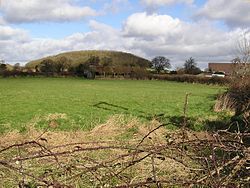Difference between revisions of "Wilcrick"
(Created page with "{{Infobox town |name=Wilcrick |county=Monmouthshire |picture=Wilcrick.jpg |picture caption=Wilcrick Hill |os grid ref=ST409879 |longitude=51.58684 |latitude=2.85443 |post town...") |
|||
| Line 5: | Line 5: | ||
|picture caption=Wilcrick Hill | |picture caption=Wilcrick Hill | ||
|os grid ref=ST409879 | |os grid ref=ST409879 | ||
| − | |longitude= | + | |longitude=-2.85443 |
| − | |latitude= | + | |latitude=51.58684 |
|post town=Caldicot | |post town=Caldicot | ||
|postcode=NP26 | |postcode=NP26 | ||
Revision as of 13:05, 31 July 2014
| Wilcrick | |
| Monmouthshire | |
|---|---|
 Wilcrick Hill | |
| Location | |
| Grid reference: | ST409879 |
| Location: | 51°35’13"N, 2°51’16"W |
| Data | |
| Post town: | Caldicot |
| Postcode: | NP26 |
| Dialling code: | 01633 |
| Local Government | |
| Council: | Newport |
| Parliamentary constituency: |
Newport East |
Wilcrick is a small village within between Newport and Magor in Monmouthshire.
The name translates from the Welsh language as "bare hill".[1] Three farms are located in the village: Church Farm, Newhouse Farm and Tump Farm.
Archaeology
To the southeast of the village is Wilcrick Hill which was a hillfort, of which the earthworks remain. Archaeological evidence, in the form of a small Iron Age settlement found preserved under peat at Barland's Farm, suggests that the occupiers probably moved inland, from the lower lying and wetter Caldicot Level, with their grazing cattle, when water-levels rose in the autumn, possibly to the hillfort which overlooks the site [2]
Nearby, a nearly complete 3rd-century Romano-British oak boat was found beside a buried stone and timber quay in 1993, during the building of a distribution depot at the nearby Europark. This suggests that much higher water levels prevailed on the Levels at the time.[3][4]
The church
The parish church is dedicated to St. Mary, with the minister historically being also the minister for Llanmartin. The only ministers not appearing also as ministers there were Peter Ameline, rector of Wilcrick in 1535 and Edmond Jones instituted to Wilcrick on 16 July 1631. After that the names and dates of ministers for both parishes are the same. The church has a bell of 1726 cast by the Evans foundry of Chepstow.[1]
Historian J.A. Bradney describes the church as comprising nave and chancel, with a bell turret at the west end and containing "nothing of interest except an ancient font". The whole edifice was rebuilt in 1860.[5]
References
- ↑ 1.0 1.1 Wilcrick at Rectorial Benefice of Magor
- ↑ British Archaeology, Issue 49, November 1999
- ↑ The Glamorgan-Gwent Archaeological Trust: Historic Landscape Characterisation The Gwent Levels
- ↑ The Newport Ship site - Barland's Farm boat
- ↑ Joseph Bradney|Bradney, J. A., A History of Monmouthshire from the Coming of the Normans Into Wales Down to the Present Time, Volume 4, Parts 1 and 2 - The Hundred of Caldicot, published 1929 and 1932